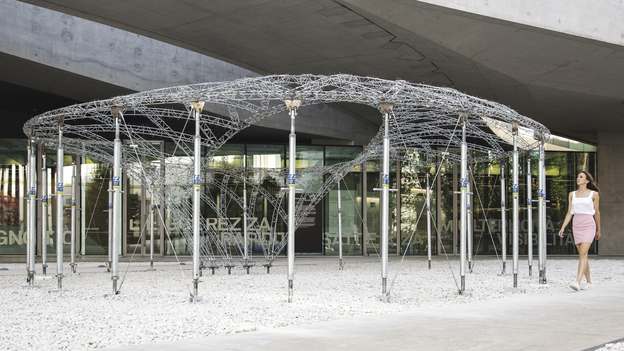This paper presents a formwork system consisting of a bending-active gridshell that simultaneously serves as falsework and integrated reinforcement for realising a ribbed funicular concrete skeleton shell. Encased by a knitted textile shuttering, the formwork system was demonstrated through KnitNervi, an architectural-scale, funnel-shaped demonstrator measuring 9 metres in diameter and 3.3 metres in height. The gridshell is materialised from straight steel rebar actively bent into curvilinear, double-layered rebar cages. Regular stirrups and pairs of inclined stirrups forming triangulated shear connectors provide the necessary shape control and stiffness for the load-bearing falsework. The rebar cages define the shape of the concrete ribs by supporting a knitted closed sectional mould and staying in place to structurally reinforce the resulting ribs.
The focus of this paper lies on the falsework and reinforcement system with its interrelated design drivers. The geometric design includes the funicular form finding of the target shell with Thrust Network Analysis and the incremental form finding of the bending-active gridshell with its informed assembly sequence towards the funicular target with Finite Element Analysis. The engineering of the falsework demonstrates its sufficient load-bearing capacity and deflection control to support the weight of the wet concrete at an architectural scale. Sensitivity studies reveal the effectiveness of activating the double layer through the shear-connecting stirrups, the relevance of the internal connection design, and the geometric integrity during a potential stepwise casting sequence. The construction of the demonstrator verified the shape control and fabrication design.
In only 36 hours, the bespoke falsework gridshell was efficiently assembled from its kit-of-parts of standard rebar elements with adequate precision, logistics, time, and material resources. It was relatively lightweight, compact for transport, and employed low-tech construction techniques common to the rebar industry. Its structural geometry and informed bending-active logic enabled its efficient construction without digital fabrication or wasteful, costly moulds, which typically present the bottleneck for custom concrete structures. The resulting funicular concrete skeleton shell saves structural mass, hence embodied carbon, compared to unarticulated bending-dominant typologies. The overarching motivation of the research is to outline a strategy that could mitigate the environmental impact of the construction sector, applicable to a broad range of technological contexts.




